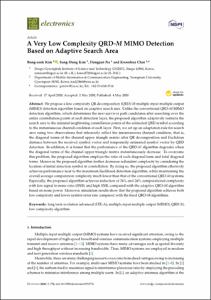A Very Low Complexity QRD-M MIMO Detection Based on Adaptive Search Area
- Title
- A Very Low Complexity QRD-M MIMO Detection Based on Adaptive Search Area
- Author(s)
- Kim, Bong-Seok ; Kim, Sang-Dong ; Na, Dongjun ; Choi, Kwonhue
- Issued Date
- 2020-05
- Citation
- Electronics, v.9, no.5, pp.756
- Type
- Article
- Author Keywords
- long term evolution advanced (LTE-A) ; multiple input multiple output (MIMO) ; QRD-M ; low complexity algorithm
- ISSN
- 2079-9292
- Abstract
- We propose a low complexity QR decomposition (QRD)-M multiple input multiple output (MIMO) detection algorithm based on adaptive search area. Unlike the conventional QRD-M MIMO detection algorithm, which determines the next survivor path candidates after searching over the entire constellation points at each detection layer, the proposed algorithm adaptively restricts the search area to the minimal neighboring constellation points of the estimated QRD symbol according to the instantaneous channel condition at each layer. First, we set up an adaptation rule for search area using two observations that inherently reflect the instantaneous channel condition, that is, the diagonal terms of the channel upper triangle matrix after QR decomposition and Euclidean distance between the received symbol vector and temporarily estimated symbol vector by QRD detection. In addition, it is found that the performance of the QRD-M algorithm degrades when the diagonal terms of the channel upper triangle matrix instantaneously decrease. To overcome this problem, the proposed algorithm employs the ratio of each diagonal term and total diagonal terms. Moreover, the proposed algorithm further decreases redundant complexity by considering the location of initial detection symbol in constellation. By doing so, the proposed algorithm effectively achieves performance near to the maximum likelihood detection algorithm, while maintaining the overall average computation complexity much lower than that of the conventional QRD-M systems. Especially, the proposed algorithm achieves reduction of 76% and 26% computational complexity with low signal to noise ratio (SNR) and high SNR, compared with the adaptive QRD-M algorithm based on noise power. Moreover, simulation results show that the proposed algorithm achieves both low complexity and lower symbol error rate compared with the fixed QRD-M algorithms. © 2020 by the authors. Licensee MDPI, Basel, Switzerland.
- Publisher
- MDPI
- Related Researcher
-
-
Kim, Sangdong
- Research Interests
-
- Files in This Item:
-
 기타 데이터 / 3.8 MB / Adobe PDF
download
기타 데이터 / 3.8 MB / Adobe PDF
download
- Appears in Collections:
- Division of Automotive Technology 1. Journal Articles



